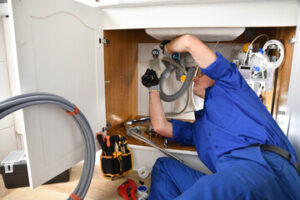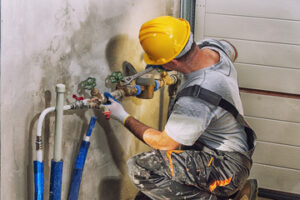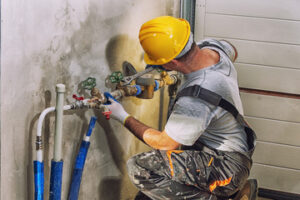Plumbing pipes convey water, waste, and venting throughout a building. Licensed plumbers install and repair these systems to ensure safe, efficient operation.

New construction and renovation projects require specialized knowledge of pipe materials, sizing, and system design. Entrusting this work to professionals ensures that the final product meets industry standards and satisfies client expectations. Contact Plumbing Installation Dallas for professional help.
A plumbing system is a complex network of pipes that conveys water, waste, and steam throughout a building. Its role is vital to a functioning home, and its installations can be more intricate than you may think.
During the design stage, your plumber creates a blueprint of your home’s plumbing layout and marks out the location of fixtures and the most efficient route for water supply and drainage. This process requires extensive knowledge of local codes and an understanding of how different components will interact with each other.
The next step is laying pipework. This involves connecting your sewer accommodation stub to the main line via a stack, and putting in any drain pipes for toilets, showers, or sinks. Any lines that run through walls, ceilings, or floors get installed at this time, too. These pipes generally connect to what’s called a vent, which keeps air flowing through the plumbing system and prevents sewer gasses from entering your home.
Some larger fixtures like bathtubs or showers can’t be set until after framing is completed and drywall has been hung, so they get installed during what’s known as the rough-in plumbing phase. This is also when any necessary water pressure adjustments can be made to ensure a comfortable flow of water.
Rough-In
Rough-in is a fundamental process that sets the foundation for installing plumbing fixtures. It involves laying pipes underground and within the walls, floor, ceiling and crawlspaces of your home or commercial property. These pipes transport essential services like water supply lines, drains and vent stacks. The plumbing rough-in process requires careful planning and adherence to building codes to ensure that it is completed accurately and on time.
It’s important to note that plumbers can’t begin the plumbing rough-in process until all of the framing is done because pipes run through wall studs and joists. This means that any changes made to the layout of the framed structure can impact how and where pipes are installed, which can lead to costly adjustments later.
Before the rough-in process begins, a plumbing contractor needs to provide their client with product specs and plans for the project. This helps them create a plan that aligns with the construction blueprint and reduces the risk of errors. It also allows the plumber to check that the proposed pipe connections comply with local plumbing codes, which can save money and avoid rework down the line.
During the rough-in plumbing stage, plumbers connect the building’s water and sewer lines to the main utility lines. This can be challenging since it requires digging a trench and then backfilling it with gravel or another material to prevent water or sewer leaks down the road. It’s also necessary to properly position the drains so that wastewater flows effectively to the sewage system or septic tank.
To make sure that the drains are positioned correctly, they’re tested for proper slope and grade. This can be a messy and time-consuming job, but it’s crucial to the safety and efficiency of the plumbing system.
Once all of the pipes are positioned and connected, it’s time to install tub and toilet drains. This involves measuring the drain lines and drilling holes for the fittings to make sure they’re in the correct location. These measurements and holes need to be accurate so that the drains can be easily connected to the toilet or tub. It’s also important to make sure that all of the connections are secure and waterproof to prevent future leaks.
Fixture Installation
Once the plumbing system is roughed in, plumbers install fixtures like sinks, toilets, tubs and showers. Since these pieces are vital for ensuring your home is properly equipped with clean water and waste disposal systems, it’s important that they’re installed correctly. Improper installation can result in water damage, mold growth and costly repairs down the line.
To avoid these issues, it’s crucial that you hire a professional to perform fixture installation. Not only will they ensure that all of your new pipes are secure and leak-free, but they’ll also work with you to choose the right fixtures for your space. From stylish designs to energy-efficient options, there are many different fixture types that can add value to your home while meeting all of your functional needs.
When installing any type of fixture, it’s essential to turn off the water supply before starting. This can be done by turning off the valves located under each sink or, if you’re working on a larger project like a bathtub or shower, by shutting off the main water valve in your house. It’s also a good idea to have all of your tools and materials organized before starting so you don’t end up having to stop in the middle of a job to go find something.
Once all of the fixtures are in place, plumbers will test them to make sure they’re functioning properly. This includes ensuring that there are no leaks and that the water is flowing at the correct pressure. This is also the time to make any necessary adjustments.
Choosing the right fixtures for your home can be tricky, as there are many factors to consider. In addition to ensuring that they match your home’s aesthetic, it’s important to select fixtures that are efficient and will stand the test of time. This is where it pays to do your research before committing to a particular style or brand.
While it may be tempting to save money by taking on DIY plumbing projects, the truth is that a lack of experience and expertise can lead to costly mistakes that result in water damage, mold growth, or even sewer backups. Instead, trust the pros at Goodbee to handle all of your plumbing fixture installations and upgrades. Our experienced team of experts will ensure that all of your plumbing fixtures are installed correctly and will last for years to come!
Final Inspection
The final inspection is the key step in construction projects that ensures that all aspects of the building comply with the governing codes, standards and specifications. The process of getting a final inspection is not to be taken lightly as it directly impacts the approval for occupancy and use of the building. As such, it is important for construction professionals to ensure that all of the steps are fully completed before scheduling a final inspection.
The plumbing system is comprised of many interconnecting components that need to work properly in order to function efficiently. A professional plumber must be able to understand the complexity of these systems in order to perform thorough inspections. In addition to ensuring that each part is installed correctly, the inspection process also includes a thorough quality control check. In this way, the plumber can identify and address any potential issues early on before they cause costly problems in the future.
During the rough-in phase, the plumbing system’s skeletal structure is put in place. This involves laying out and connecting the water supply lines, drain lines, and venting systems. The plumber may also consult with a designer to create a piping plan that offers both functionality and aesthetic appeal.
After the plumbing skeleton is in place, it’s time to install the fixtures. This involves connecting the sinks, toilets, showerheads and appliances to the water supply and drainage systems. As a result, the plumber must have a good understanding of how each fixture will interact with the other in terms of flow and pressure. In addition, the plumber must consider factors like water temperature and waste disposal to ensure that each system works as intended.
This article provides a comprehensive overview of the plumbing inspection process in new construction, major renovations and repairs, and other maintenance tasks. With the help of a reputable plumber, you can rest assured that your building’s plumbing system will be in good hands. With their knowledge of the latest building codes and regulations, a professional plumber can ensure that all aspects of your plumbing are in compliance.

